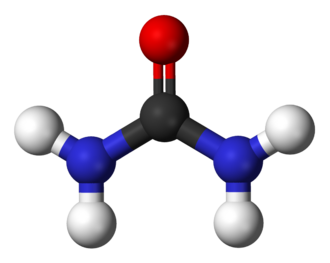Chemistry:Blood urea nitrogen
| Blood urea nitrogen | |
|---|---|
| Medical diagnostics | |
 | |
| MeSH | D001806 |
| LOINC | 6299-2, 59570-2, 12961-9, 12963-5, 12962-7 |
Blood urea nitrogen (BUN) is a medical test that measures the amount of urea nitrogen found in blood. The liver produces urea in the urea cycle as a waste product of the digestion of protein. Normal human adult blood should contain 7 to 18 mg/dL (0.388 to 1 mmol/L) of urea nitrogen.[1] Individual laboratories will have different reference ranges, as the assay used can vary between laboratories.[2][3][4] The test is used to detect renal problems. It is not considered as reliable as creatinine or BUN/creatinine ratio blood studies.[1]
Interpretation
BUN is an indication of renal (kidney) health. The normal range is 2.1–7.1 mmol/L or 6–20 mg/dL.[1]
The main causes of an increase in BUN are: high-protein diet, decrease in glomerular filtration rate (GFR) (suggestive of kidney failure), decrease in blood volume (hypovolemia), congestive heart failure, gastrointestinal hemorrhage,[5] fever, rapid cell destruction from infections, athletic activity, excessive muscle breakdown, and increased catabolism.[1]
Hypothyroidism can cause both decreased GFR and hypovolemia, but BUN-to-creatinine ratio has been found to be lowered in hypothyroidism and raised in hyperthyroidism.
The main causes of a decrease in BUN are malnutrition (low-protein diet), severe liver disease, anabolic state, and syndrome of inappropriate antidiuretic hormone.[5]

Another rare cause of a decreased BUN is ornithine transcarbamylase deficiency, which is a genetic disorder inherited in an X-linked recessive pattern. OTC deficiency is also accompanied by hyperammonemia and high orotic acid levels.
Units
BUN is usually reported in mg/dL in some countries (e.g. United States, Mexico, Italy, Austria, and Germany). Elsewhere, the concentration of urea is reported in SI units as mmol/L.
represents the mass of nitrogen within urea/volume, not the mass of whole urea. Each molecule of urea has two nitrogen atoms, each having molar mass 14 g/mol. To convert from mg/dL of blood urea nitrogen to mmol/L of urea:
Note that molar concentrations of urea and urea nitrogen are equal, because both nitrogen gas and urea has two nitrogen atoms.
Convert BUN to urea in mg/dL by using following formula:
Where 60 represents MW of urea and 14*2 MW of urea nitrogen.
See also
- Kt/V
- Standardized Kt/V
- Urea reduction ratio
- Urine urea nitrogen
References
- ↑ 1.0 1.1 1.2 1.3 Lewis, Sharon Mantik; Dirksen, Shannon Ruff; Heitkemper, Margaret M.; Bucher, Linda; Harding, Mariann (5 December 2013). Medical-surgical nursing : assessment and management of clinical problems (9th ed.). St. Louis, Missouri. ISBN 978-0-323-10089-2. OCLC 228373703.
- ↑ Tao Le; Vikas Bhushan; Deepak Rao (2007). First Aid for the USMLE Step 1 2008. New York: McGraw-Hill Medical. Last page. ISBN 978-0-07-149868-5. https://archive.org/details/firstaidforusmle00taol.
- ↑ "Normal Lab Results". Marshal University School of Medicine. http://musom.marshall.edu/usmle/usmlelabvalues.htm.
- ↑ "Blood urea nitrogen (BUN) test - Mayo Clinic". https://www.mayoclinic.org/tests-procedures/blood-urea-nitrogen/about/pac-20384821.
- ↑ 5.0 5.1 Longo. Harrison's Principles of Internal Medicine (18th ed.). p. 611.[full citation needed]
 |

